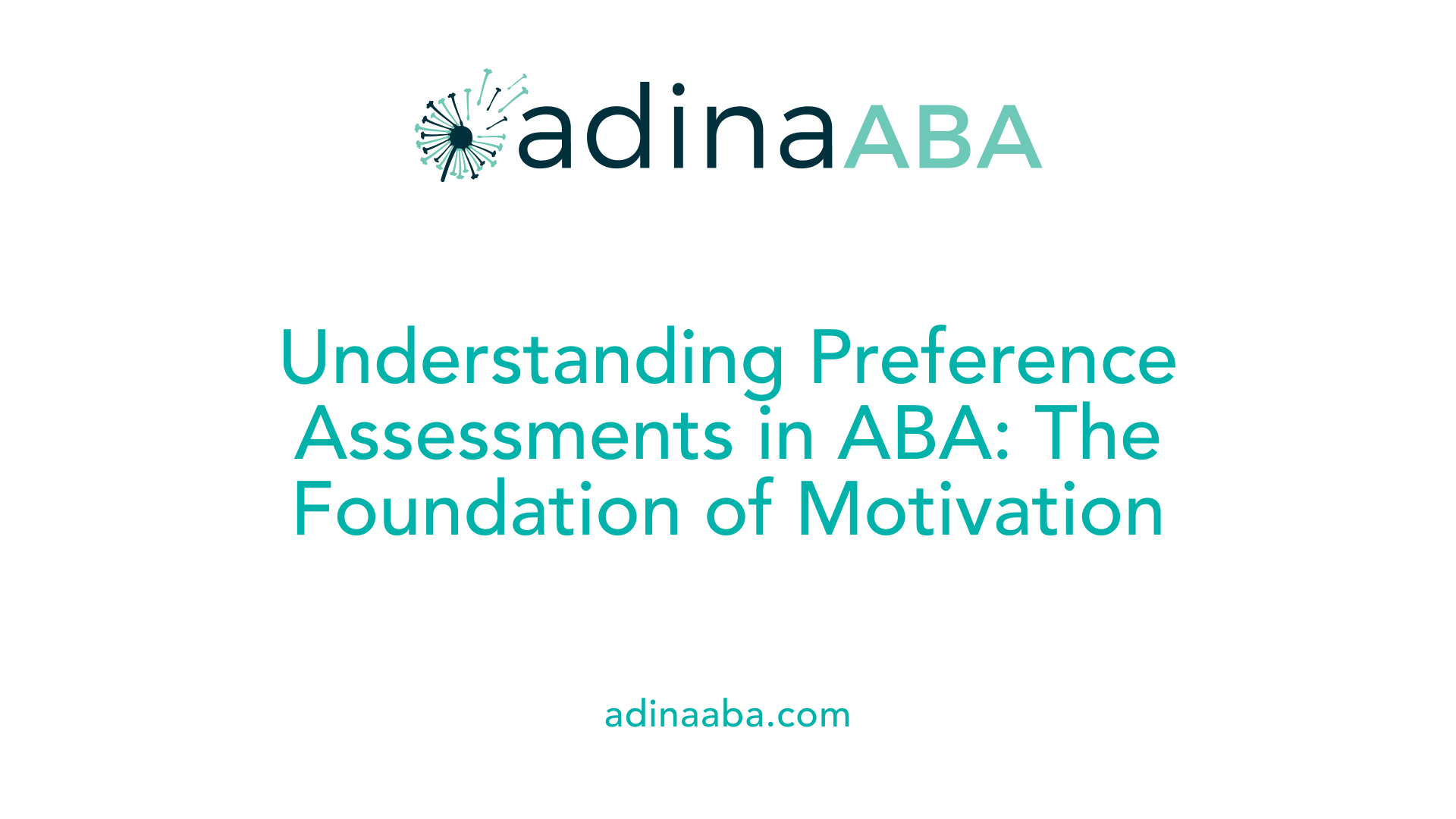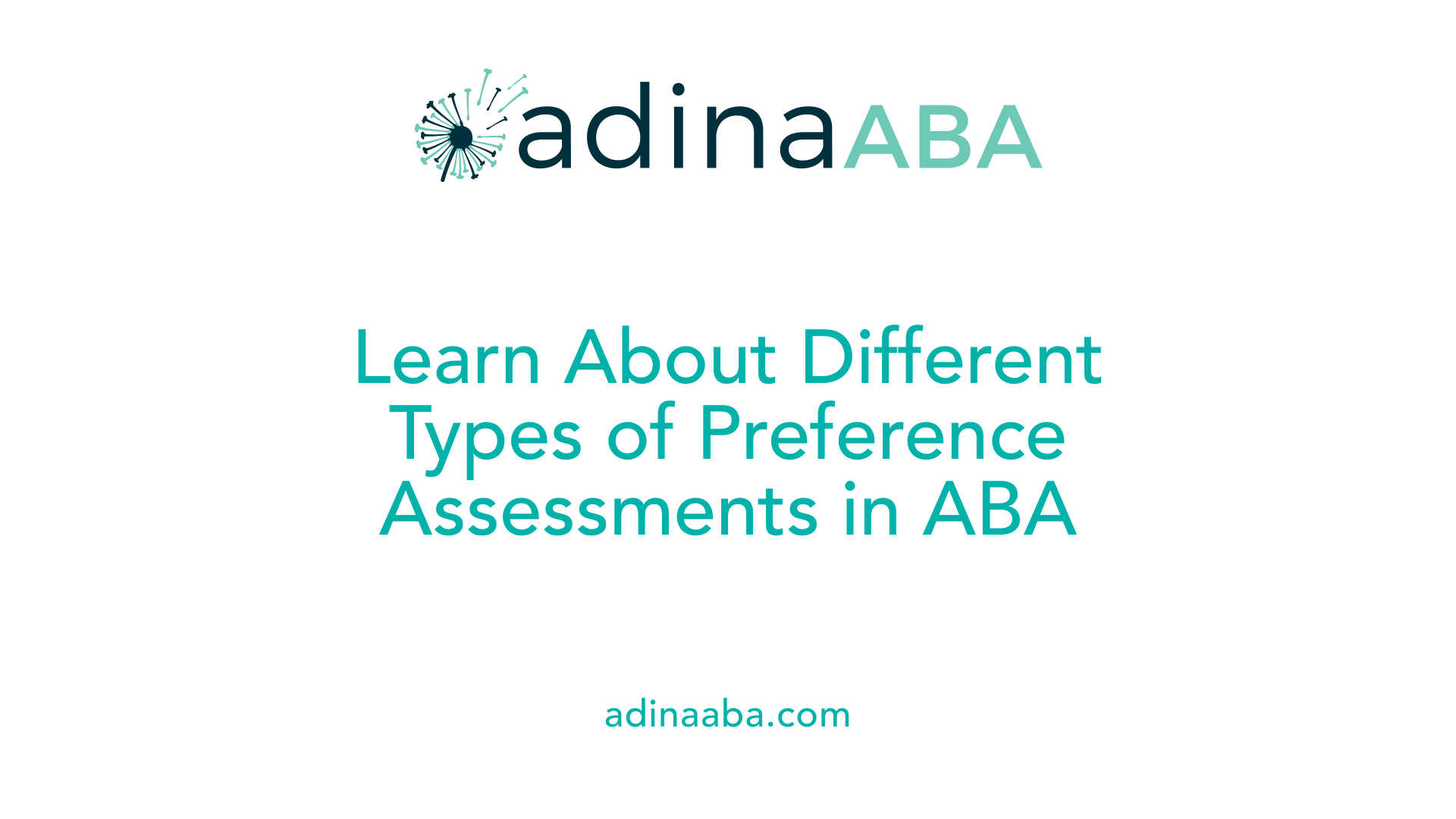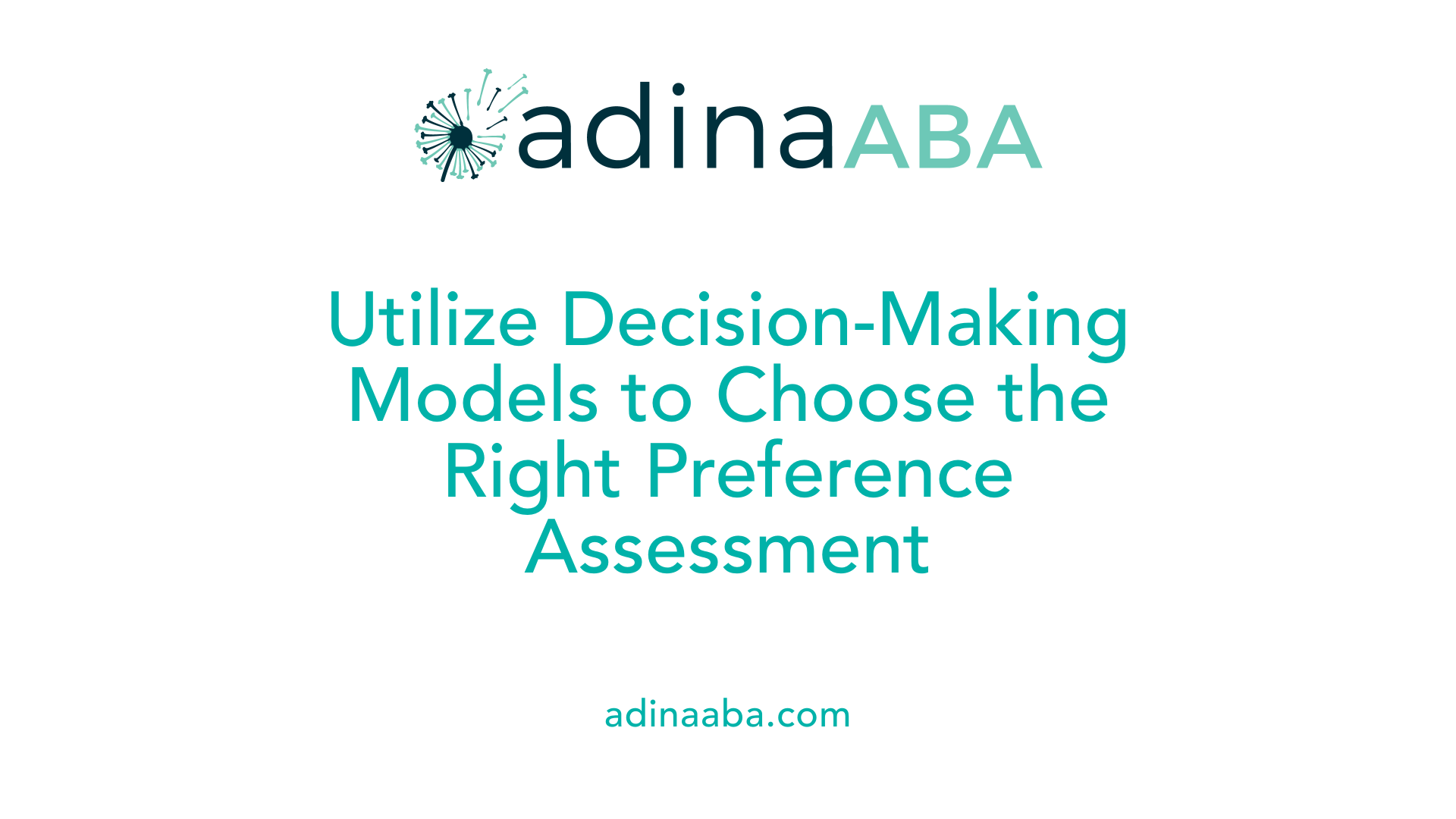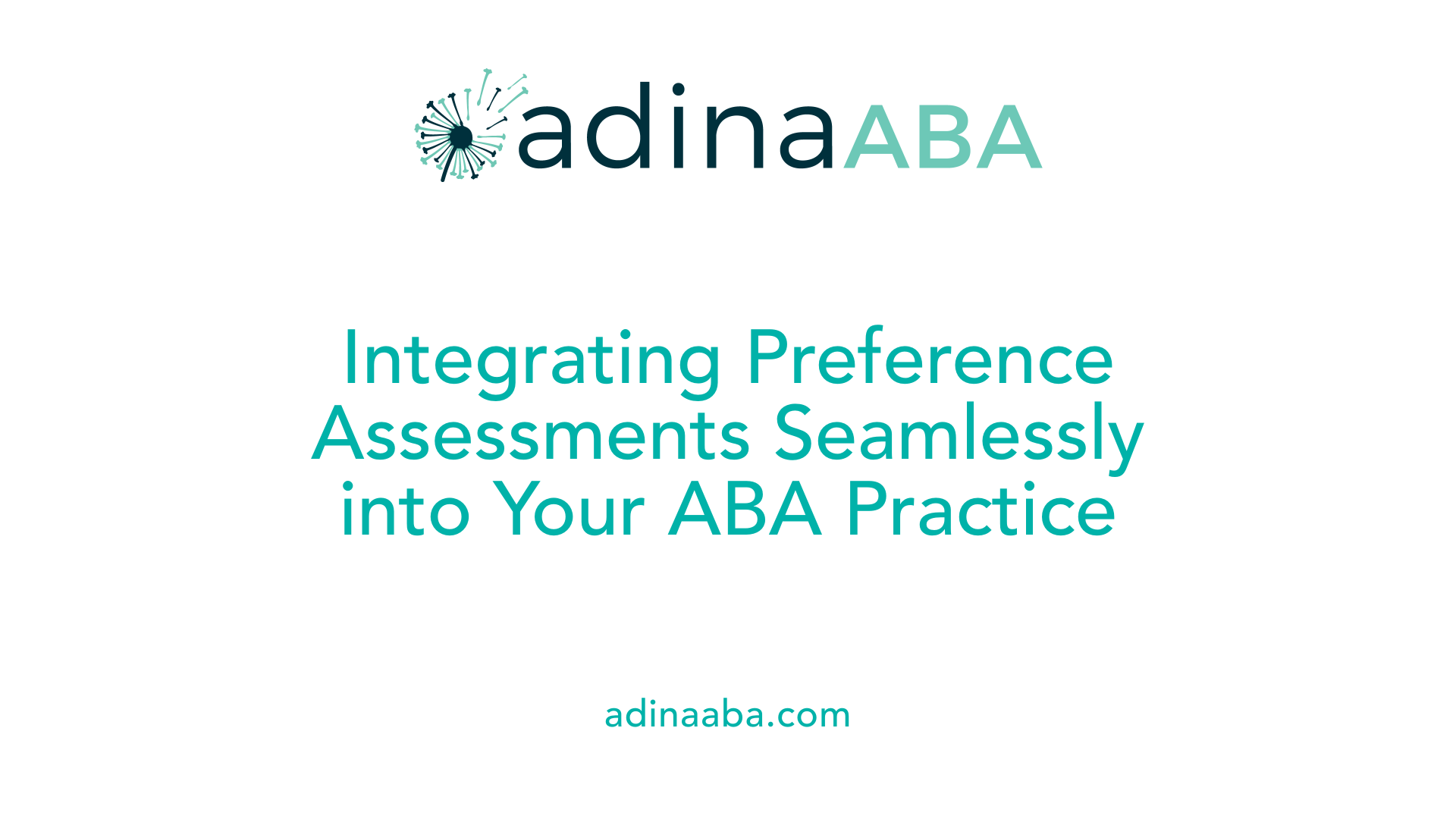Using preference assessments in ABA

Understanding the Foundation of Reinforcement in ABA
Preference assessments are integral to effective applied behavior analysis (ABA) practices. They serve as a systematic method to identify stimuli that an individual finds motivating and reinforcing, which forms the cornerstone for developing personalized interventions. By understanding what a learner prefers, practitioners can tailor reinforcement strategies that enhance engagement, increase desirable behaviors, and foster meaningful progress. This article explores the various methods, types, significance, and practical application of preference assessments within ABA therapy, emphasizing their role in individualizing and optimizing intervention outcomes.
Defining Preference Assessments in ABA

What are preference assessments in ABA?
Preference assessments are structured techniques used within Applied Behavior Analysis (ABA) to determine what stimuli—such as toys, foods, activities, or social interactions—a person finds motivating. These assessments help identify potential reinforcers that can be used to encourage positive behaviors.
How do preference assessments identify motivating stimuli?
Different methods are employed to explore a person's preferences. For example, free operant observations involve watching how a person interacts spontaneously with various items over time. Structured trial-based procedures, like paired stimulus or multiple stimulus assessments, systematically present choices to see which items are most frequently selected. The consistency of these choices helps establish a hierarchy of preferred stimuli.
Some assessments involve indirect methods, such as asking caregivers or using questionnaires, which gather insights into preferences that may not be easily observed. These approaches can include open-ended questions or ranking exercises to quickly identify highly preferred items.
What is the role of preference assessments as reinforcers?
The primary purpose of preference assessments is to find stimuli that can function as effective reinforcers, increasing the likelihood of desired behaviors. Once identified, these preferred items are used during therapy to motivate and reinforce appropriate responses. Regularly updating preference assessments ensures that reinforcement remains effective as individual preferences may change over time.
By systematically identifying what motivates each individual, practitioners can tailor interventions that are engaging and effective. This personalized approach helps maximize therapy success and supports meaningful progress.
| Method Type | Description | Suitable For | Notes |
|---|---|---|---|
| Free operant observation | Observing spontaneous interactions with stimuli | Individuals with limited communication skills | Can be naturalistic or contrived environments |
| Paired stimulus | Presenting two items to choice | Communicative or capable individuals | Efficient for many ages and abilities |
| Multiple stimulus (MSW/MSWO) | Presenting multiple items; removing or replacing chosen ones | Those who can discriminate among many options | Establishes preference hierarchy |
| Single stimulus | Showing one item at a time; recording reactions | Less capable individuals or initial screening | Simple, easy to implement |
| Asking caregivers or individuals | Indirect method via interviews or surveys | When direct observation isn't feasible | Adds valuable context and prior knowledge |
Preference assessments are vital tools that enable practitioners to discover what truly motivates an individual, supporting more personalized and effective ABA therapy. Regular use of these procedures helps ensure that reinforcement strategies stay aligned with changing preferences, maximizing intervention impact.
Methods and Procedures for Conducting Preference Assessments

What are the main methods of conducting preference assessments?
There are several effective ways to identify what a learner finds most engaging, known as preference assessments. The most common methods include Single Stimulus, Paired Stimulus, and Multiple Stimulus assessments.
Single Stimulus assessments involve presenting one item at a time to the learner and recording their response — such as engagement or reaction. This method is especially useful for learners who have difficulty choosing between options or scanning multiple items.
Paired Stimulus assessments, also called forced-choice tests, present two items at a time. The learner is asked to choose between them, providing clear data on relative preferences. This approach is valuable when a learner can make choices but may struggle with larger arrays.
Multiple Stimulus assessments display several items simultaneously. These tests can be conducted with or without replacement: in the multisite with replacement (MSW) method, chosen items are replaced, allowing repeated opportunities for preference assessment; while in the multiple stimulus without replacement (MSWO), selected items are removed, helping establish a hierarchy of preferences.
Each of these methods helps practitioners identify highly preferred items that serve as effective reinforcers. By understanding preferences through structured observation and testing, therapists can tailor interventions to boost motivation and learning outcomes.
In addition to direct testing methods, some assessments involve asking caregivers or stakeholders about preferences through interviews, questionnaires, or rankings. This indirect approach supports initial identification of potential reinforcers, especially when direct testing may be challenging.
Further, knowledge of what triggers behavior — including understanding antecedent-behavior-consequence (ABC) analysis — complements preference data. Combining preference assessment results with ABC data allows for more personalized and effective intervention planning.
Structured vs. naturalistic approaches
Preference assessments can be conducted in structured settings, such as clinical rooms or therapy centers, or naturally in the learner’s regular environment. Structured assessments, like controlled presentations of stimuli, provide consistent and measurable data.
Naturalistic assessments, including free operant observation, involve observing the individual during typical daily activities or free play, capturing spontaneous preferences that may be more representative of their true interests.
Both approaches are valuable. Structured assessments allow for clearer comparisons and data collection, while naturalistic assessments help confirm preferences in real-world contexts.
Use of data collection and analysis
Accurate data collection during preference assessments involves recording which items are chosen, the duration of engagement, and frequency of interactions. Data is then analyzed to determine hierarchies of preference or to identify stimuli that reliably function as reinforcers.
For example, in a multiple stimulus without replacement test, the order of selection reflects the individual’s preference ranking. In paired stimulus assessments, the item most often chosen indicates higher preference.
Analyzing these preferences helps practitioners select reinforcers that are motivating for the individual. This tailored approach enhances therapy effectiveness by promoting engagement and encouraging desired behaviors.
Tracking preference changes over time through repeated assessments ensures the relevance of chosen reinforcers, as interests may shift with age, experience, or circumstances.
| Method | Description | Suitable For | Additional Notes |
|---|---|---|---|
| Single Stimulus | Present one item, record response | Learners with scanning/choice difficulties | Quick, easy to administer |
| Paired Stimulus | Present two items; record choice | When relative preferences are needed | Ideal for precise preference ranking |
| Multiple Stimulus (with/without replacement) | Several items presented; selected items replaced or removed | Efficient ranking, multiple items | MSWO helps establish hierarchy |
Understanding these methods and their appropriate applications supports effective preference assessment, ultimately informing better reinforcement strategies tailored to each individual.
Classification and Types of Preference Assessments

What are some common types of preference assessments in ABA?
In applied behavior analysis (ABA), practitioners use various methods to identify what a learner finds most motivating. These are called preference assessments, and they help determine which stimuli can serve as effective reinforcers.
Some of the most common types include free operant observations, single stimulus tests, paired stimulus tests, multiple stimulus with replacement (MSW), and multiple stimulus without replacement (MSWO). Each method has unique features suited to different learners' abilities and contexts.
Free operant observations involve observing the learner during natural or structured free time with access to many items. The practitioner notes what the learner interacts with and how long they engage, helping identify naturally preferred stimuli.
Single stimulus assessments present only one item at a time. The observer records the learner’s reactions, which is helpful for children who may have difficulty choosing among multiple options or scanning many stimuli.
Paired stimulus assessments show two items at once, and the learner chooses between them. This method is ideal for establishing a preference ranking when comparing limited options.
Multiple stimulus with replacement (MSW) presents several items simultaneously. When the learner chooses an item, it is replaced, allowing repeated exposure to each stimulus. This helps clarify which stimuli are most preferred over time.
Multiple stimulus without replacement (MSWO) also presents multiple items but removes each chosen item from the array. This approach helps quickly establish a hierarchy of preferences based on the order of selection.
Advantages and disadvantages
Advantages of these methods include their ability to accurately identify highly preferred stimuli that can be used as reinforcers, thus increasing motivation and engagement during therapy.
Disadvantages may involve the time required to conduct assessments, the possibility that preferences change over time, and that some methods might not be suitable for learners with certain disabilities or cognitive levels. For instance, paired stimulus assessments require learners to compare options directly, which can be challenging for some.
In practice, practitioners select the most appropriate assessment based on the learner’s abilities, setting, and the goal of the assessment. Regular evaluation ensures that reinforcement strategies remain effective as preferences shift over time.
| Method | Description | Suitable For | Main Advantage | Main Limitation |
|---|---|---|---|---|
| Free operant observation | Observing spontaneous engagement | All learners, natural settings | Naturalistic insights | Less structured, less control |
| Single stimulus | Presenting one item | Learners with scanning difficulties | Simple, quick | Limited comparison data |
| Paired stimulus | Two items presented, choice recorded | Comparison of specific items | Clear preference ranking | Time-consuming with many items |
| MSW | Multiple items, replaced after selection | Establishing preference hierarchy | Repeated exposure | May require more trials |
| MSWO | Multiple items, removed after selection | Quick hierarchy establishment | Efficient, easy to interpret | May favor familiar items |
Understanding these assessment types and their advantages helps practitioners design effective reinforcement strategies that are tailored to each learner’s preferences and abilities.
The Significance of Conducting Preference Assessments Regularly

Why are preference assessments important in ABA?
Preference assessments are essential tools in applied behavior analysis (ABA) because they enable practitioners to identify what stimuli—such as toys, activities, or social interactions—are most motivating for an individual. Knowing a person's preferences allows therapists to select effective reinforcers that increase the likelihood of desired behaviors. This targeted approach not only enhances engagement but also makes therapy sessions more personalized and effective.
A well-conducted preference assessment ensures that reinforcement strategies are aligned with what truly motivates the learner. Consequently, interventions tend to be more successful, fostering better learning outcomes and improving behavior management.
How often should preference assessments be conducted?
Preferences can change over time due to various factors such as age, environment, or exposure to different stimuli. Therefore, it is recommended that preference assessments be carried out regularly during therapy sessions.
Repeated assessments help therapists stay informed of the individual’s current likes and dislikes, ensuring reinforcers remain motivating. In practice, the frequency of these evaluations varies depending on the person’s needs and the stability of their preferences.
For children with rapidly changing interests or in dynamic environments, assessments might be done monthly or even more frequently. For others with more stable preferences, quarterly or biannual reassessments may suffice.
By updating reinforcement strategies based on current preferences, practitioners can sustain motivation, prevent burnout, and adapt to the learner’s evolving interests.
How do changing preferences impact reinforcement effectiveness?
Unawareness or neglect of a learner’s changing preferences can lead to less effective reinforcement, reducing motivation and decreasing the likelihood of engagement in targeted behaviors. For instance, a toy that was highly preferred last month might no longer appeal to the learner.
Regular preference assessments help identify such shifts promptly, allowing for the adjustment of reinforcers. This dynamic process ensures that therapy remains relevant and effective, ultimately supporting greater behavior change and skill acquisition.
Strategies for periodic assessment
Practitioners can use various methods to regularly evaluate preferences:
- Observation-based assessments: observing spontaneous interactions during sessions or natural environments.
- Structured trials: using paired-stimulus, multiple stimuli, or single-stimulus presentations.
- Interviews and questionnaires: engaging caregivers, teachers, or the individuals themselves whenever possible.
- Ranking or ordinal assessments: having individuals or caregivers rank items from most to least preferred.
Incorporating these strategies into routine practice helps maintain an up-to-date understanding of what motivates the learner, making reinforcement strategies more effective and personalized.
Applications of Preference Assessments in Treatment Planning
 Preference assessments are fundamental tools in ABA therapy that help practitioners understand what motivates a learner. By systematically evaluating the child's interests, therapists can select effective reinforcers, which are essential for promoting and maintaining desired behaviors.
Preference assessments are fundamental tools in ABA therapy that help practitioners understand what motivates a learner. By systematically evaluating the child's interests, therapists can select effective reinforcers, which are essential for promoting and maintaining desired behaviors.
How are preference assessments conducted in practice?
These assessments typically involve presenting various stimuli to the individual and observing their responses. Depending on the child's abilities, different methods are used. Paired stimulus assessments present two items at a time, and the child's choice reveals their preference. Single stimulus assessments involve showing one item and noting the response or engagement level. Multiple stimulus assessments present several items simultaneously; the child’s selections or engagement duration are recorded to generate a preference hierarchy.
In addition to these, practitioners may use free operant observation, where the child is observed in a naturalistic environment with open access to toys and activities, or employ techniques like eye gaze or engagement-based measures for learners with limited communication skills.
Preference assessments can be classified into direct methods, such as systematic presentation and observation, and indirect methods, like caregiver interviews and questionnaires. The selection of methods depends on factors such as the child's developmental level, resource availability, and specific goals.
Regularly updating these assessments ensures that reinforcement strategies stay aligned with the child's current interests. Identifying high-preference items allows therapists to formulate personalized intervention plans, thereby increasing motivation and the likelihood of successful learning.
In summary, conducting thorough preference assessments, through various structured and naturalistic approaches, enables effective reinforcement selection. This directly enhances the overall effectiveness of ABA treatment by tailoring interventions to what genuinely motivates each individual, supporting sustained learning and behavior change.
Decision-Making Frameworks and Models for Preference Assessment Selection

What are decision-making models related to preference assessments?
Practitioners use various decision-making models to select the most suitable preference assessment methods tailored to each individual's needs. Among these, three prominent models stand out: the in situ decision-making model, an a priori algorithm, and the SPADS model.
The SPADS model, which stands for Stimulus Preference and Demand System, is designed to systematically guide practitioners through selecting procedures based on multiple factors. It considers stimulus dimensions such as size, novelty, and class, alongside client-specific characteristics like their ability to scan or discriminate stimuli. The model also accounts for outcome agreement, ensuring the selected method aligns with the assessment's goal, and evaluates motivational operations, such as deprivation states, that influence responses.
These models are supported by a robust body of research. Empirical findings highlight the importance of stimulus class, novelty, and portion size in predicting reinforcer effectiveness. For example, the size of a stimulus or its novelty can significantly impact the likelihood that a particular item will serve as an effective reinforcer.
In integrating research evidence, these decision-making frameworks optimize the selection and application of assessment methods such as single stimulus, paired stimuli, or multiple stimuli procedures. The goal is to enhance the predictive validity of preference assessments, thereby improving their role in reinforcing desired behaviors.
By applying these models, practitioners can make more informed choices that increase the accuracy of identifying effective reinforcers, ultimately supporting more engaging and successful interventions.
| Model Name | Main Focus | Key Factors Considered | Typical Use Cases |
|---|---|---|---|
| In situ decision-making | Real-time assessment adaptation | Immediate responses, environmental context | Dynamic settings with fluctuating preferences |
| A priori algorithm | Pre-evaluation planning | Known client preferences, environmental constraints | Early assessment phases |
| SPADS | Systematic, research-based | Stimulus attributes, client characteristics, motivational state | Comprehensive assessment, predictive accuracy |
This strategic approach ensures preference assessments are both effective and adaptable, tailored to the individual child's unique preferences and circumstances.
Practical Considerations for Implementing Preference Assessments

What are some practical considerations for implementing preference assessments?
When incorporating preference assessments into ABA therapy, practitioners must plan carefully to ensure the process is effective and efficient. First, understanding resource needs is crucial. This includes considering the time needed to conduct assessments, the materials such as toys, reinforcers, or visual aids required, and the available space for observation or testing.
Selecting suitable assessment methods based on the individual is also essential. For example, children with limited communication skills may benefit more from free operant observations or single stimulus assessments, while others might be able to engage in paired choices or rank ordering.
Timing is another key factor. Conducting assessments when the individual is alert and motivated increases the likelihood of obtaining accurate data. Many practitioners recommend periodic re-evaluation, as preferences can shift over time, especially with young children or those undergoing behavioral changes.
Flexibility in adapting assessments to individual needs enhances their usefulness. If a child's attention span is short, shorter sessions or breaks might be needed. Incorporating caregivers or other stakeholders can provide additional insight and support, promoting consistency across environments.
Incorporating these practical considerations ensures that preference assessments serve their purpose effectively—identifying motivating stimuli that can be used to reinforce desired behaviors and tailor interventions to each learner’s interests.
Integrating Preference Assessments into ABA Practice

Strategies for consistent use
Consistency is essential when implementing preference assessments in ABA therapy. Practitioners should conduct assessments regularly to capture changes in the individual's preferences, which can fluctuate over time. Incorporating brief initial assessments in each session or at scheduled intervals ensures that reinforcement remains motivating. Using a variety of assessment methods—such as free operant observations, paired stimuli, and rank ordering—helps gather comprehensive data and mitigates the risk of preference fatigue or skewed results.
Documenting and analyzing preference data systematically supports consistent decision-making. Feedback from caregivers and teachers can also inform ongoing assessments, especially in natural environments. Training staff to understand the importance of routine preference checks and to accurately record observations is crucial for sustaining effective reinforcement strategies.
Benefits of ongoing assessment
Regular preference assessments serve multiple benefits. They help identify stimuli that are highly motivating, which are more likely to reinforce desired behaviors. This ongoing process ensures that interventions stay relevant as preferences evolve, maximising engagement and learning outcomes.
Furthermore, periodic reassessment can prevent the reliance on outdated reinforcers and helps in discovering new motivators. This adaptability enhances treatment durability and promotes generalization of skills across settings and times.
Training requirements for practitioners
Effective use of preference assessments requires specialized training for practitioners. They must understand various assessment methods, such as single stimulus presentations, paired choices, and free operant observations. Training should include recognizing when and how to apply each method, analyzing data, and interpreting results to select suitable reinforcers.
Moreover, practitioners need to be skilled in conducting assessments ethically and accurately, especially with children or individuals with disabilities. Familiarity with guidelines set by the Behavior Analyst Certification Board (BACB) ensures procedures are scientifically valid and ethically sound. Ongoing professional development should emphasize new research findings and innovative assessment tools to maintain high standards of practice.
Final Thoughts on Preference Assessments in ABA
Incorporating comprehensive and regular preference assessments into ABA therapy is essential for delivering effective, individualized interventions. By systematically identifying motivating stimuli and using appropriate assessment methods, practitioners can optimize reinforcement strategies, increase client engagement, and foster meaningful behavioral change. As preferences can evolve over time, ongoing assessment and adaptation are key to maintaining the relevance and impact of reinforcement within ABA programs. Ultimately, the deliberate use of preference assessments not only enhances treatment efficacy but also respects and supports the unique interests and motivation of each individual.
References
- Types of Preference Assessments in ABA - AllDayABA
- What Are Preference Assessments in ABA?
- A Comprehensive Guide to Preference Assessments in ABA
- Preference Assessments - EBIP - VKCSites.org
- Stimulus Preference Assessment Decision-Making System (SPADS)
- Preference Assessments in ABA Therapy - Circle Care Services
- Preference Assessment: An ABA Technique - Golden Care Therapy
- Types of Preference Assessments in ABA - AllDayABA
- Preference Assessments - EBIP - VKCSites.org
More Resources
Expert Clinicians
Get started today ->






